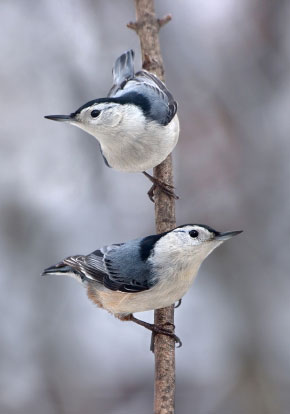Sitta carolinensis
If a White-breasted Nuthatch wanted to read this account of itself, it would likely flip the page. Why? Because we are talking about the “upside-down” bird! The nickname comes from a typical foraging pattern. Nuthatches tend to fly to the top of a tree trunk, and forage their way down the trunk in a spiraling pattern. Once they reach the base of the tree, they fly to the next and repeat the pattern. As they move down, they use their thin, pointed bill to probe the crevices of the bark looking for insect and seed morsels. When they find food, they may wedge it into a bark crevice and hammer it open.
These acrobats of the woods have a white face and breast and blue-grey upperparts. The differences between the sexes are subtle. The male?s crown is black while the female’s is a dark grey. You may also notice a rusty wash of color on the flanks. Compared to the Red-breasted Nuthatch and other nuthatch species, this bird is the largest. The call of the White-breasted Nuthatch is a nasal “ank…ank…ank.”
Nuthatches are found in most areas of the U.S. They are a resident species that prefers mature, deciduous woods. In areas where the conifers dominate the landscape, you are more likely to find their cousins, the Red-breasted Nuthatch. White-breasted Nuthatches prefer nesting and foraging along the edges of woodlots rather than deep within the forest. If your home is bordered by woods, then your yard fits the bill.
During the summer months the nuthatches prefer insects for food. But come fall, winter, and spring and their diets turn to mast (the nuts and seeds of trees). Aspen Song® Chickadee mix is rich in nutmeats, sunflowers, and corn…nuthatch favorites all. Nuthatches also hoard food, hiding seeds in bark crevices and sometimes covering their store with a piece of bark or lichen.
In the summer months, expect to find nuthatches visiting your yard in pairs. During the winter they often join mixed foraging flocks of chickadees and titmice as they move through the neighborhood from feeder to feeder.
Nuthatch pairs use natural cavities in trees or old woodpecker holes to build their nest, often reusing the same cavity in successive years. If your woodlot houses a snag (dying tree) with old woodpecker holes in it, don’t remove it. Leave it for the nuthatches and they will reward you with frequent forays to your feeders.
Reference
Grubb, Jr., T. C. and V. V. Pravosudov. 2008. White-breasted Nuthatch (Sitta carolinensis), The Birds of North America Online (A. Poole, Ed.). Ithaca: Cornell Lab of Ornithology.

